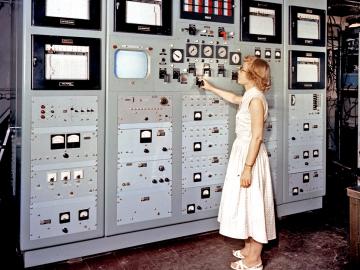
Filter News
Area of Research
News Topics
- (-) Frontier (4)
- (-) Nuclear Energy (20)
- (-) Physics (2)
- (-) Polymers (1)
- 3-D Printing/Advanced Manufacturing (4)
- Advanced Reactors (2)
- Artificial Intelligence (6)
- Big Data (7)
- Bioenergy (28)
- Biology (43)
- Biomedical (9)
- Biotechnology (7)
- Buildings (1)
- Chemical Sciences (6)
- Clean Water (8)
- Composites (2)
- Computer Science (11)
- Coronavirus (5)
- Education (1)
- Energy Storage (3)
- Environment (59)
- Exascale Computing (5)
- Fusion (16)
- Grid (1)
- High-Performance Computing (13)
- Hydropower (5)
- ITER (2)
- Machine Learning (5)
- Materials (2)
- Materials Science (2)
- Mathematics (3)
- Mercury (6)
- Microscopy (7)
- Nanotechnology (2)
- National Security (2)
- Neutron Science (1)
- Partnerships (2)
- Security (1)
- Simulation (11)
- Summit (7)
- Transportation (1)
Media Contacts

ORNL will team up with six of eight companies that are advancing designs and research and development for fusion power plants with the mission to achieve a pilot-scale demonstration of fusion within a decade.

As renewable sources of energy such as wind and sun power are being increasingly added to the country’s electrical grid, old-fashioned nuclear energy is also being primed for a resurgence.

ORNL is teaming with the National Energy Technology Laboratory to jointly explore a range of technology innovations for carbon management and strategies for economic development and sustainable energy transitions in the Appalachian region.

The Center for Bioenergy Innovation has been renewed by the Department of Energy as one of four bioenergy research centers across the nation to advance robust, economical production of plant-based fuels and chemicals.

Millions of miles of pipelines and conduits across the United States make up an intricate network of waterways used for municipal, agricultural and industrial purposes.

Tomás Rush began studying the mysteries of fungi in fifth grade and spent his college intern days tromping through forests, swamps and agricultural lands searching for signs of fungal plant pathogens causing disease on host plants.

ORNL researchers are deploying their broad expertise in climate data and modeling to create science-based mitigation strategies for cities stressed by climate change as part of two U.S. Department of Energy Urban Integrated Field Laboratory projects.

ORNL has provided hydropower operators with new data to better prepare for extreme weather events and shifts in seasonal energy demands caused by climate change.

Researchers in the geothermal energy industry are joining forces with fusion experts at ORNL to repurpose gyrotron technology, a tool used in fusion. Gyrotrons produce high-powered microwaves to heat up fusion plasmas.

Oak Ridge National Laboratory physicist Elizabeth “Libby” Johnson (1921-1996), one of the world’s first nuclear reactor operators, standardized the field of criticality safety with peers from ORNL and Los Alamos National Laboratory.


